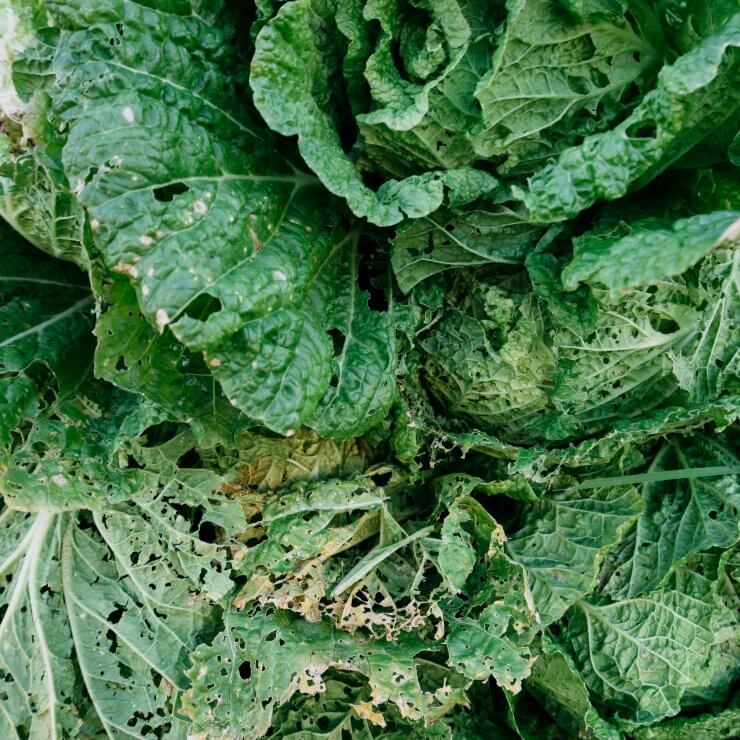
Diseased lettuce plants in the garden
Like all food crops, lettuce plants are susceptible to various fungal diseases. Your greatest weapons against these are best planting practices, which help prevent disease in the first place.
This is especially important, as there are no fungicides approved for home use for many diseases.
These best practices are aimed at producing strong, healthy lettuce that can withstand disease, and at avoiding situations that contribute to the development of disease. They involve keeping plants clean, dry, and undamaged.
Watering: Water your lettuce plants lightly several times a week (check the soil for dryness). Do not over-water; lettuce plants hate having wet feet! Soggy soil invites disease. If you can, use a soaker hose rather than an overhead hose of sprinkler.
Mulch: Mulch can help with water retention—but be vigilant and check for insect or fungal activity.
Other best practices include:
- Buy healthy, disease-free plants from reputable sources
- Plant your lettuce in full sun
- Plant in sites with good drainage; if planting in open ground, choose a higher spot for better drainage
- Harvest frequently and remove any infected plants
Common lettuce diseases
Here are some of the usual culprits that might infest your lettuce. Remember, it’s important to remove diseased leaves to prevent the spread of disease once it’s found its way onto your lettuce.
Damping-off
Cause: Fungus
Symptoms:
- infected roots are gray and water-soaked
- seedlings grown before infection collapse and die
- older plants that get infected are severely stunted
How it Spreads:
- spores thrive in moist soil and cool temperatures
Treatment:
- liquid copper fungicide, if infection is severe
- remove and discard infected parts
Prevention:
- minimize soil moisture
- break up compacted soil
- plant in well-draining areas
- treat seeds with fungicides before planting
Downy Mildew
Cause: Fungus
Symptoms:
- pale spots on long patches on leaves
- gray-purple fuzzy growth on leaf surface
- leaves turn pale, then yellow
- leaf tips collapse
How it Spreads:
- splashing water (rain, irrigation) disturbs spores
- cool temperatures favor growth
Treatment:
- destroy infected plants
- apply foliar fungicides
Prevention:
- purchase disease-free plants
- plant in well-draining areas
- homemade fungicides
- choose planting sites with good air movement
Fusarium Wilt
Cause: Fungus
Symptoms:
- leaves wilt and turn yellow
How it Spreads:
- splashing water (rain, irrigation) disturbs spores
- warm temperatures favor growth
Treatment:
- destroy infected plants
Prevention:
- purchase disease-free plants
- plant in well-draining areas
- homemade fungicides
- choose planting sites with good air movement
Septoria Blight
Cause: Fungus
Symptoms:
- irregular pale spots on the oldest leaves
- lesions enlarge, turn brown, and dry out
- leaves look tattered
How it Spreads:
- splashing water (rain, irrigation) disturbs spores
- cool temperatures favor growth
Treatment:
- destroy infected plants
Prevention:
- purchase disease-free plants
- avoid working in the garden when plants are wet
- plant in well-draining areas
- choose planting sites with good air movement
Other diseases that can affect your lettuce crop include:
- Cucumber Mosaic Virus
- Tomato Spotted Wilt Virus
- White Mold
- Aster Yellows (transmitted by the aster leafhopper)
In most cases, the best defense against disease in your lettuce crop is to provide adequate watering and avoid overwatering. Watering early in the morning gives your plants a chance for the sun to dry their leaves so fungal diseases can’t latch on. Make sure the soil you plant your lettuce in has good drainage. Purchase disease-resistant seeds and plants.
Which diseases have you had to treat on your lettuce plants? Please tell us how you prevent and handle diseases. If you spot other symptoms on your lettuce plants that are not mentioned here, contact your local extension center or garden center for a consult—and please let us know what you discover.

 Previous
Previous

